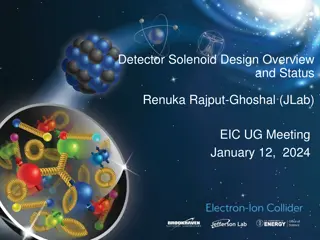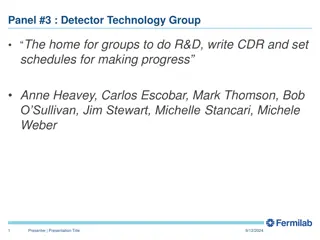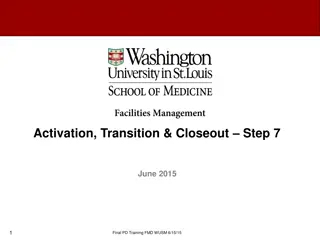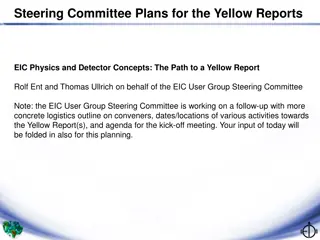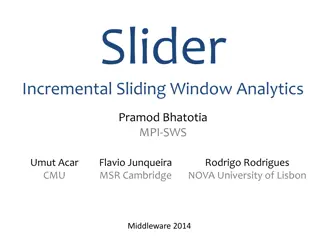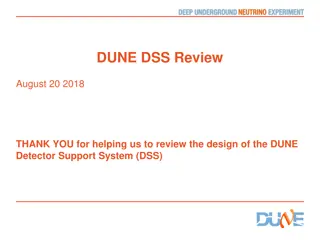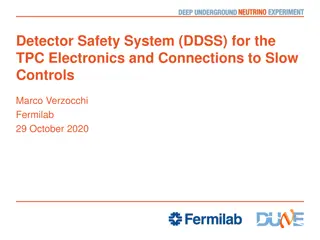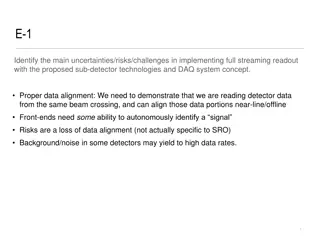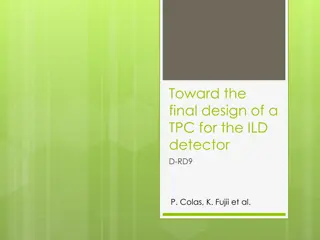Closeout Report: Incremental Design Review of EIC Detector Electronics
Closeout report detailing the progress of the Incremental Preliminary Design and Safety Review of the EIC Detector DAQ and Electronics, along with the Final Design Review of Electronics Components for the ePIC Detector. The report includes responses to charge questions, panel reviews, comments, recommendations, and conclusions regarding technical performance requirements, documentation of electronics and data acquisition plans, schedule assumptions, ES&H and QA considerations, and more.
Download Presentation

Please find below an Image/Link to download the presentation.
The content on the website is provided AS IS for your information and personal use only. It may not be sold, licensed, or shared on other websites without obtaining consent from the author.If you encounter any issues during the download, it is possible that the publisher has removed the file from their server.
You are allowed to download the files provided on this website for personal or commercial use, subject to the condition that they are used lawfully. All files are the property of their respective owners.
The content on the website is provided AS IS for your information and personal use only. It may not be sold, licensed, or shared on other websites without obtaining consent from the author.
E N D
Presentation Transcript
Closeout Report Ken Wyllie (CERN), Mitch Newcomer (UPenn), Prashansa Mukim (BNL), Filippo Costa (CERN) IncrementalPreliminary Design and Safety Review of the EIC Detector DAQ and Electronics and Final Design Review of Electronics Components for the ePIC Detector June 10-11, 2024
Outline Charge Questions Review Panel Response to Charge Questions Comments Recommendations Conclusion 2
Charge Questions 1. Are the technical performance requirements appropriately defined and complete for this stage of the project? 2. Are the plans for the various detector electronics and data acquisition systems appropriately documented and complete for this stage of the project? 3. Are the current plans from front-end electronics to data acquisition for the detector likely to achieve the technical performance requirements, with a low risk for cost increases, schedule delays, and technical problems? 4. Are the schedule assumptions for the fabrication of the various electronics and data acquisition systems and assembly plans reasonable and consistent with the overall detector schedule? 5. Have ES&H and QA considerations been adequately incorporated into the plans at their present stage? 3
Review Panel Ken Wyllie Mitch Newcomer Prashansa Mukim Filippo Costa CERN Upenn BNL CERN 4
Response to Charge Questions 1. Are the technical performance requirements appropriately defined and complete for this stage of the project? Yes. The teams are working towards well-defined specifications of the front-end ASICs for processing the detector signals. The requirements for ReadOut/DAQ/controls are less mature but acceptable for this stage of the project. The remaining steps to bring these to maturity appear to be well defined. 5
Comments We applaud the adaptation of the readout architectures to match detector environment specs, in particular for the dRICH where steps to mitigate the high DCR will be implemented in the ASIC together with other handles such as triggering within the DAM. We appreciate these steps towards robustness. However, it would be reassuring to see simulations or measurements to demonstrate the effectiveness of the shuttering mechanism for dRICH. The RO/DAQ architecture is evolving in the right direction, but some specifications are yet to be fully defined and this should now move ahead at speed to allow implementation (RDOs in particular) to start. We feel that a dedicated overview and discussion on the slow-controls would have been helpful for the review, in particular from the point-of-view of hardware/firmware. 6
Recommendations Rationalize the dRICH readout with the benefit of simulation/measurement to re- assure the community of the benefit of the shutter implementation. We recommend to include a dedicated overview and discussion on the slow-controls in a subsequent review. To achieve the next level of maturity of the RO/DAQ architecture and based on the experience of recent experiment upgrades, we recommend the following steps: Fix the definition of protocol between DAM and RDO. The general architecture of the command (and trigger) distribution from GTU to DAMs/RODs must be developed and specified further. The trigger (foreseen as a mitigation of excessive data volume) is not yet mature and may introduce as yet unforeseen complications. This should be developed. Define the performance requirements of DAQ systems at different stages of the development. Define the DAQ/control requirements from sub-detectors from the perspective of testing and validation. This was an important step during the evolution of the recent upgrades at the LHC. If many variants of RDO and or DAMs are indeed required, the division of responsibilities should be discussed and clarified. Central support must be properly resourced. This was massively underestimated in recent LHC upgrades. Plans to evaluate techniques to reduce data volume should be developed in data challenges, as they might have large impact on the data rate and performance of the DAQ system. A table showing how many DAM boards and readout server are assigned to each detector should be provided for completeness. Dataflow from the FEE to the STORAGE must be better described. 7
Response to Charge Questions 2. Are the plans for the various detector electronics and data acquisition systems appropriately documented and complete for this stage of the project)? Yes The ASIC documentation is mostly mature and complete. The RO/DAQ documentation/plans are less mature but appropriate for this stage of the project. The completion of the these is on the right track and the remaining steps are being formulated. 8
Comments We encourage the pursuit of synergy and encourage further steps in this direction in the RDO developments. This can only help with the documentation and definition of interfaces. 9
Recommendations In particular for the ASICs, the reviewing procedures must be carefully planned and inserted appropriately into the planning. Key dates must be chosen to allow realistic reviewing and time for revision if recommended as an outcome of the reviews. The full specification for the FCFD architecture was not presented. It was stated this will largely follow the previous ETROC ASIC for CMS, but this must be clearly documented for the ePIC framework. Documentation of interfacing between RDOs and DAMs should be finalized, from the perspective of both DAQ and controls. 10
Response to Charge Questions 3. Are the current plans from front-end electronics to data acquisition for the detector likely to achieve the technical performance requirements, with a low risk for cost increases, schedule delays, and technical problems? Yes However, for the ASICs, the remaining development steps must be concluded and reviewed carefully. That being said, all results from prototyping are encouraging and show progress everywhere. For RO/DAQ, risk has been minimized by the choice of FELIX as the DAM implementation. Similarly, the RDO architecture and synergy across sub- systems will help to minimize risk. 11
Comments There was little information on the MAPS system/implementation, and hence no comments are possible. Given that there is a strong physical overlap between sensor and electronics, we suggest the inclusion of more information on the tracker in the next review. We appreciate the move towards digital-on-top design for the EICROC and CALOROC designs. For the EICROC/CALOROC designs, there is a worry that human resources for digital design may be limited in the key institutes. This must be monitored closely. Can collaborative help be identified and injected in a strategic manner to enhance the likelihood of success? 12
Recommendations For the ASICs, all remaining steps towards the conclusion of development must be clearly defined and progress monitored. This was a clear lesson from recent experience in the LHC projects. One point of worry is the packaging strategy for the ALCOR ASIC and the corresponding in power (and signal?)-routing. Has this been extracted and simulated carefully to enhance confidence in the V3 design? And is there a clear route to successful flip-chip packaging, either through a vendor or a collaborating institute? Maximal effort must be dedicated to resolve this as it is a deviation away from the power/signal/packaging concepts used through the successful prototyping steps. For the CALOROC & SALSA, it was unclear how the 40/50 MHz sampling would translate into the 100MHz BX regime and the time-tagging of the hits. This should be clarified and documented. 13
Response to Charge Questions 4. Are the schedule assumptions for the fabrication of the various electronics and data acquisition systems and assembly plans reasonable and consistent with the overall detector schedule? Yes However, there is little room for margin in the ASIC scheduling. The RO/DAQ components (HW,FW,SW) are more comfortable, but should not be allowed to slip. So, we strongly encourage finalizing all interface definitions (protocols) as soon as possible. 14
Comments We suggest that the plan for a triggered RO be rationalized coherently across the experiment. If it is to be pursued in some sub-systems, it should be worked out while considering the full readout chain (ASIC through to RDO and DAM for each sub-system implicated in the trigger) in case design modifications are required. 15
Recommendations For the ASICs, we recommend a strong monitoring of the progress towards finalization of the designs and the decision making between options (eg CALOROC v1A or v1B) For RO/DAQ, we recommend the outstanding protocol definitions to be fixed to allow progress, as well as the clear definition of responsibilities, synergies and sharing. We strongly recommend a clearer definition from the sub-detectors of their DAQ/control needs and quantities, and how these develop in time (short-term for prototyping and long-term for scaling up of the sub-systems). 16
Response to Charge Questions 5. Have ES&H and QA considerations been adequately incorporated into the plans at their present stage? Yes, ES&H issues are correctly under consideration and included in planning. Similarly, QA steps are being folded into the planning. 17
Comments The QA steps towards ASIC production have been assessed and seem to be well under control at this stage of the process and for the ASICs discussed during this review. Similarly, QA considerations for the RDO designs have started. We assume that QA for the DAM is guaranteed by the ATLAS programme. We advise studying the possibility to group ASIC submissions for Engineering and Production Runs (eg the 65nm chips). This will complicate scheduling but may help to reduce costs. 18
Recommendations The team designing the discrete component readout (calorimeter) must rationalize their approach to radiation qualification and assurance of the COTS components. 19
Response to Charge Questions for Electronics Components for the ePIC Detector FDR 1. Are the technical performance requirements and subsystem interfaces complete and documented? Yes, user documentation and test results of the lpGBT/VTRX+ are complete and available. Their implementation in the ePIC systems (tracker and dRICH) is correctly defined and documented. 2. Do the design and specifications meet the performance requirements with a low risk of cost increases, schedule delays, and technical problems? Yes, the performance requirements are met. They are known to be reliable and are already widely used in the LHC community. lpGBT cost is fixed, they are available and are production-tested. For the VTRX+, confirmation of scheduling & cost is expected later in summer 2024 after a general meeting between the assembly contractor, the CERN technical team, and CERN procurement. This additional production will also cover requests from ALICE, LHCb & others experiments. 3. Are the fabrication and assembly plans consistent with the overall project and detector schedule? Yes, their availability is consistent with the ePIC schedule. lpGBTs are available now. VTRX+ parts are projected to be available in 2026. Sample parts are available for ePIC prototyping. 20
4. Are the plans for integration of the VTRX+ and lpGBT in specific ePIC detector subsystems appropriately developed? Yes, the integration plans are well developed, and the remaining steps are defined. 5. Have ES&H and QA considerations been adequately incorporated in the design and procurement planning? Yes, ES&H issues have been correctly considered. QA is guaranteed by the qualification procedure at the manufacturers and monitored by CERN. User-support from CERN can also be put in place. 6. Is the procurement approach sound and the procurement schedule credible? Yes, the procurement schedule pends confirmation of the VTRX+ production schedule. 21
Comments VTRX+ pigtail lengths must be defined at least 6 months in advance of VTRX+ production. The mechanical designs of both sub-systems are well on track to allow this definition on schedule. We advise that the Inner Tracker fully test the lpGBTs (230) to be sure of full operation at 39.4 MHz. On their suitability as 'long-lead procurement components These components are a unique and cost-effective solution which requires financial commitment now to allow purchase of near-to-obsolete components and formally close a manufacturing contract with the assembly company. There will be no alternative available on the time-scale of ePIC which meets the technical specifications. 22
Conclusion We appreciate the great effort to prepare for this review. We congratulate the ePIC community on the enormous progress in the electronics and data-acquisition. We are satisfied with the answers to the charge questions provided by the contributors We have provided comments and made recommendations which we believe will be beneficial to the ePIC community. 23



